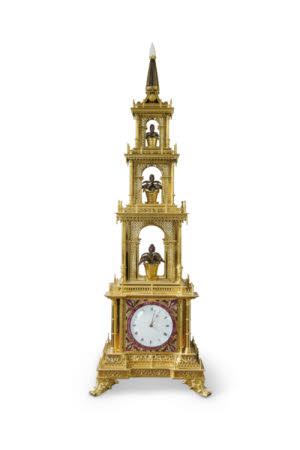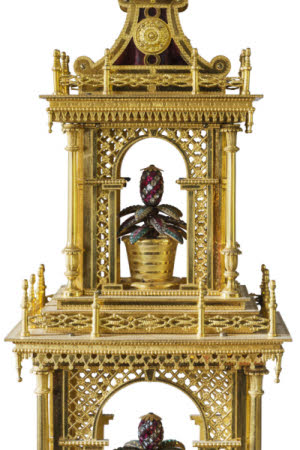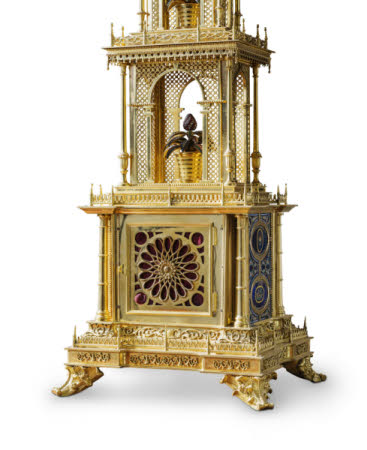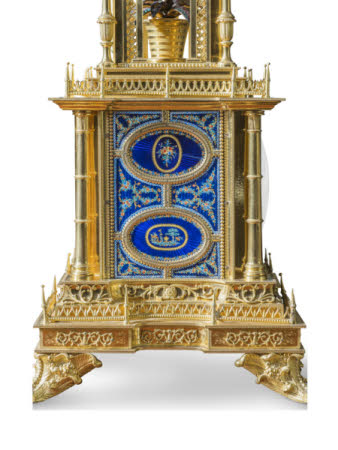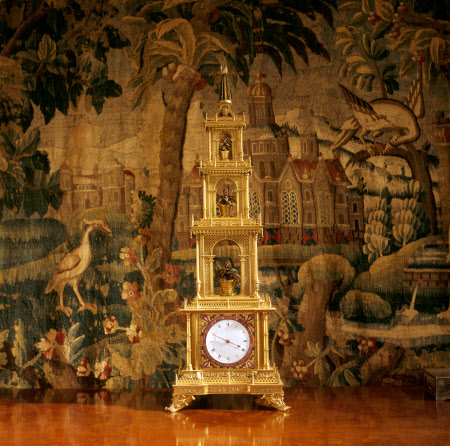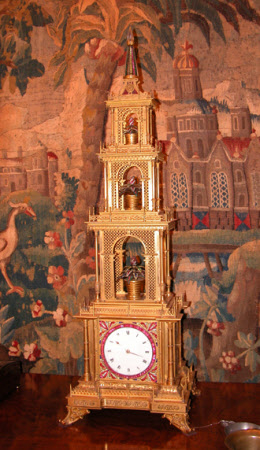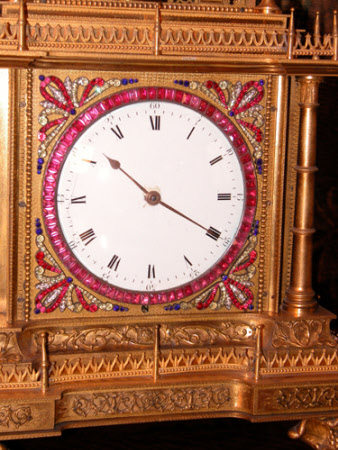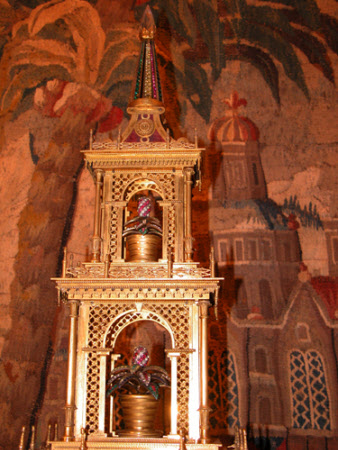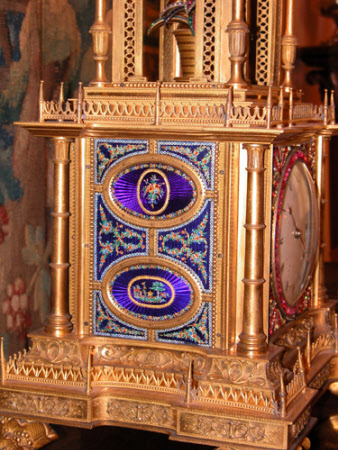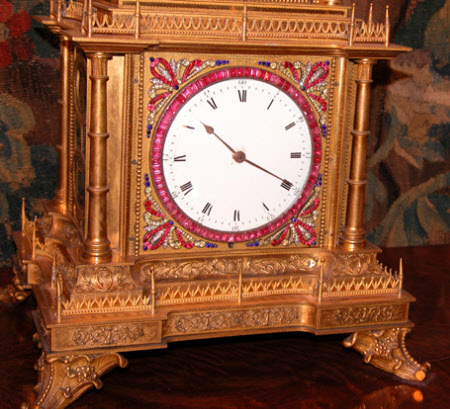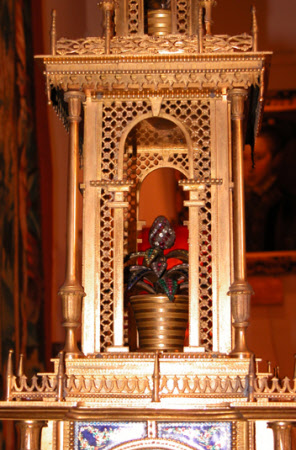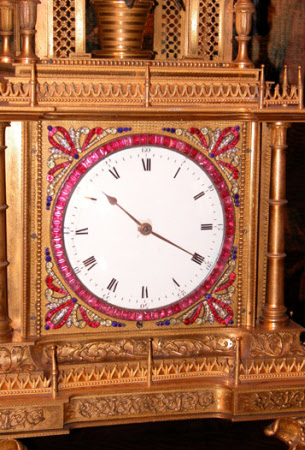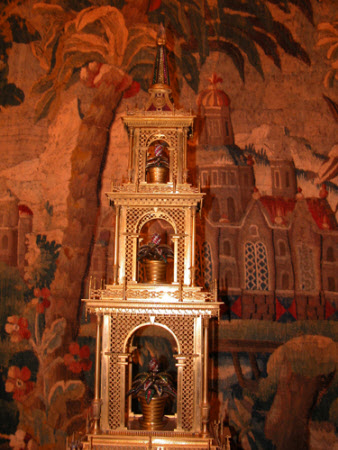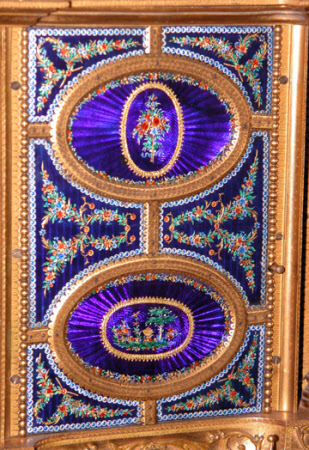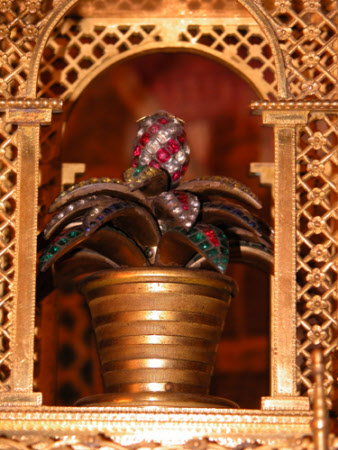Pagoda clock
John Mottram
Category
Horology
Date
c. 1800
Materials
Gilt metal, enamel, paste
Measurements
110 x 36.6 x 30.1 cm
Place of origin
London
Order this imageCollection
Anglesey Abbey, Cambridgeshire
NT 514745
Caption
If you are fortunate enough to arrive at the right time at Anglesey Abbey in Cambridgeshire, you can see and listen to a delicate mechanical performance. This clock, in the shape of a pagoda, not only tells the time but also puts on an automated spectacle once a day: a tune plays upon 12 bells, while three jewelled pineapple plants on each tier of the pagoda lift from their pots and spin around. This rare and impressive clock is attributed to the eminent 18th-century jeweller and automaton-maker James Cox (1723–1800), who created other mechanical automata for an international market. This clock appears to have been exported to China, where there was a taste for European musical and automaton clocks at the Chinese imperial court.
Summary
Gilt metal and enamelled musical tower clock, made for the Chinese market, in multi-tiered form like a pagoda, the base level with an enamelled dial, the upper three tiers enclosing miniature tubs of flowers mounted in coloured pastes, topped by an obelisk finial. The clock was made in London around 1800, probably by the clockmaker John Mottram (active 1790–1808). The replacement clock dial and movement are by Henry Borrell, c. 1825, who was working in London between 1790 and 1840.
Full description
English clocks began to be exported to China in the late sixteenth century. By the eighteenth century, imported luxury clocks and automata – known in England as ‘sing-songs’ – were a prominent feature of the collections of Chinese emperors and high-ranking court officials, who called them 'self-chiming bells' or zimingzhong. Clocks became part of courtly gift giving traditions, with courtiers and overseas visitors presenting spectacular clocks to the Qianlong emperor, who would in turn give clocks to his courtiers. This pagoda clock has historically been attributed to the London jeweller and entrepreneur James Cox (c. 1723-1800), but it is not mentioned among the clocks known to have been produced and exhibited by him. The replacement clock dial and movement are by Henry Borrell, who was working in London between 1790 and 1840, but he is not thought to have been the maker of the original movement and case. The musical movements of two clocks elsewhere which are very similar to the two pagoda clocks at Anglesey Abbey were both supplied by John Mottram, who was active between 1790 and 1808, so there is a good chance that he also supplied the original movements of the Anglesey Abbey clocks in around 1800. The pagoda clock functions as a timepiece, music player and automaton. Once a day a tune plays upon 12 bells, while three jewelled pineapple plants on each tier of the pagoda lift from their pots and rotate. The individual tunes have not been identified but are of a type of folk music known as Scottish Airs. This clock and two others now in the collection at Anglesey Abbey were purchased from the London antique dealer Charles Roberson (Robersons of Knightsbridge) around 1923–5. The catalogue describes the clocks as having been ‘gathered by an Irish gentleman during the course of his world travels before the Great War’, though this individual has not been identified, or the story verified. Although the details of its history of ownership are not known, there is evidence that this clock was once in China. Fragments of Chinese newspaper and a leaflet found inside the clock during conservation treatment have a date range of between 1912 and 1914, giving an indication of the date it may have left the country. The paper was probably used to wedge the decorative enamelled panels to stop them from moving and becoming damaged during transit. Clocks of this type were usually made in pairs and the pagoda clock is no exception. Its companion was in the collection of a Miss Derry by 1934 until it was sold by her niece in 1968. It appeared on the market again in 1980 (Bonhams, Knightsbridge, 12 December 1980, lot 60) and was acquired by Ann and Gordon Getty from Jeremy Ltd. of London in 1981. It was sold as part of their collection by Christie's New York on 20 October 2022 (lot 8). The musical movement of this partner clock was made by John Mottram, who worked in London from 1790–1808, suggesting that he was also involved in the creation of the Anglesey Abbey pagoda clock. The clock is scratched with the signature of the clock restorer, Harold Carter-Bowles (1889–1961), who worked on the clock prior to its sale by Roberson.
Provenance
Probably in China during the 19th century and until c. 1914; with the London antiques dealer Charles Roberson (Robersons of Knightsbridge), allegedly acquired from 'an Irish gentleman'; purchased by Huttleston Rogers Broughton (1896–1966), c. 1923–5; bequeathed by Broughton (by then 1st Baron Fairhaven) to the National Trust, 1966.
Makers and roles
John Mottram, horologist Henry Borrell (fl.1795 - 1840), horologist Harold Carter-Bowles (1889 - 1961) , restorer
References
Calnan 2016: C. Calnan ‘A ‘Sing-Song’ Restored. The innovative conservation of Anglesey Abbey’s Pagoda Clock’ ABC Bulletin, Autumn 2016, pp. 1-3. Bevan 2015: P. Bevan ’The Pagoda Clock at Anglesey Abbey’ (2015) https://www.bicc.ac.uk/files/2016/03/The-Pagoda-Clock-at-Anglesey-Abbey.docx (accessed March 2021) Bevan 2016: P. Bevan ‘The Qianlong Emperor’s English Clocks: To China and Back – Baubles, Bells and Booty’, Transactions of the Oriental Ceramics Society, Vol. 81, 2016-17, pp. 103-110 Bevan 2016: P. Bevan ‘Tracing the Chinese Origins of Two Automata Clocks from Anglesey Abbey’ ABC Bulletin, Autumn 2016, pp. 3-4.
